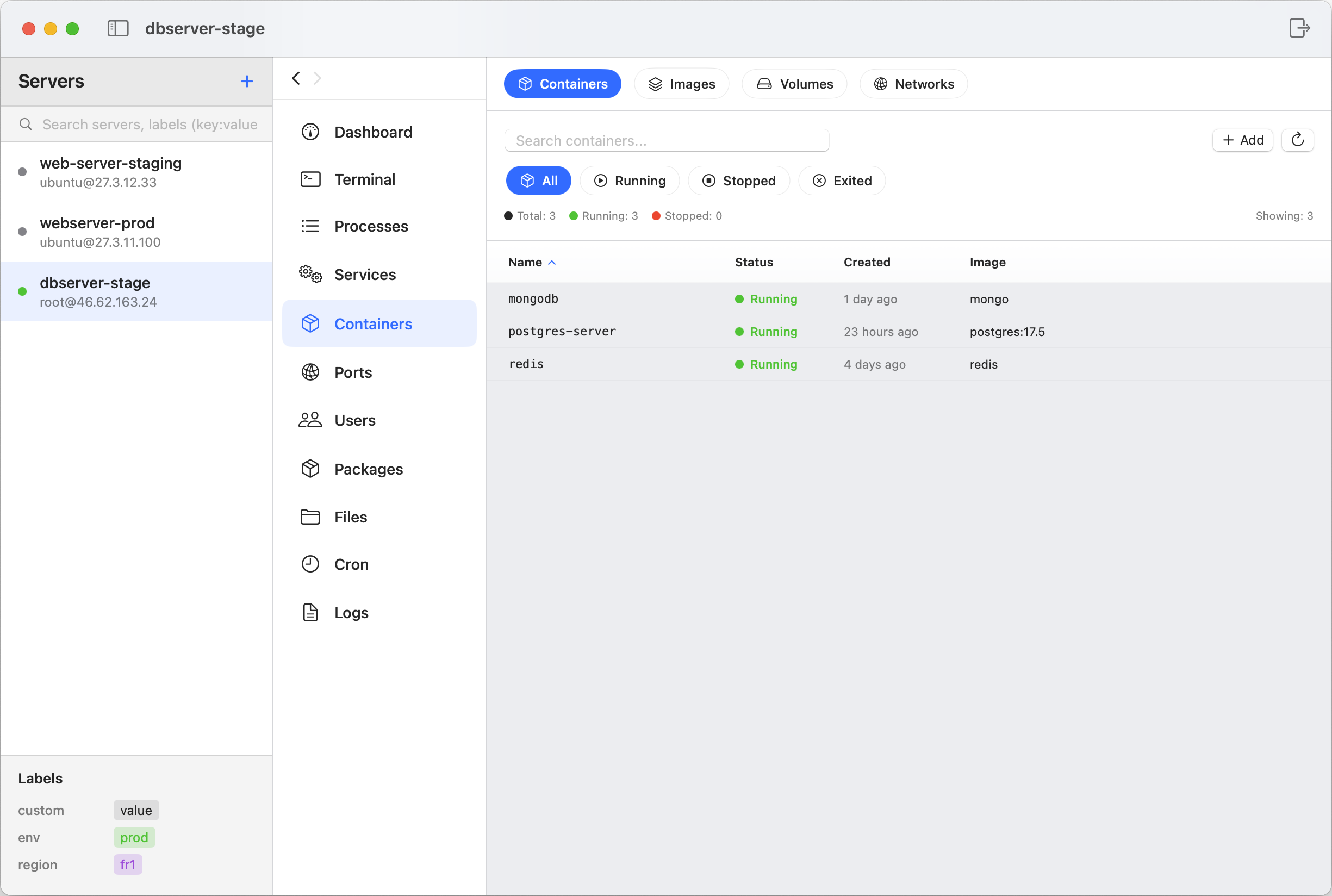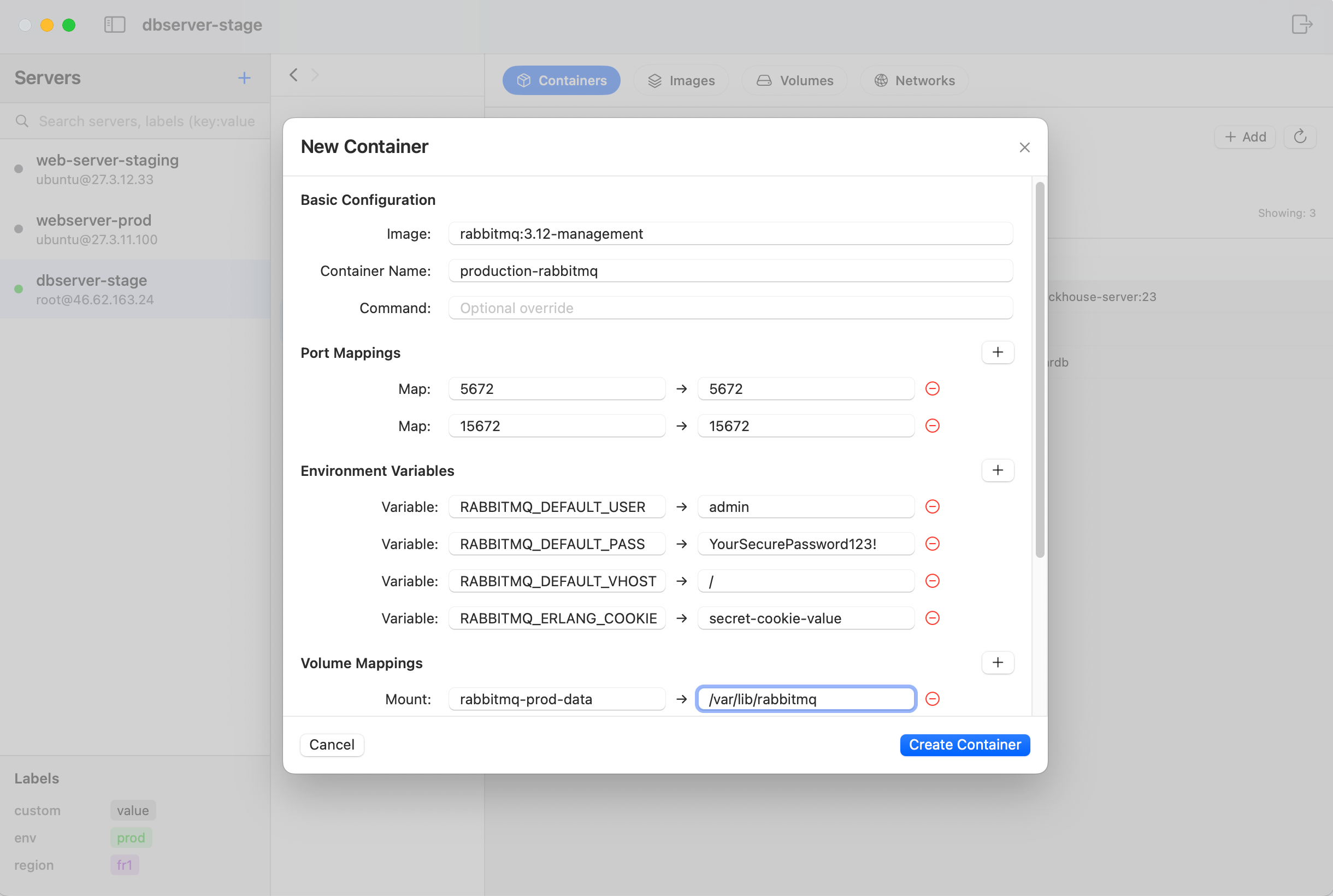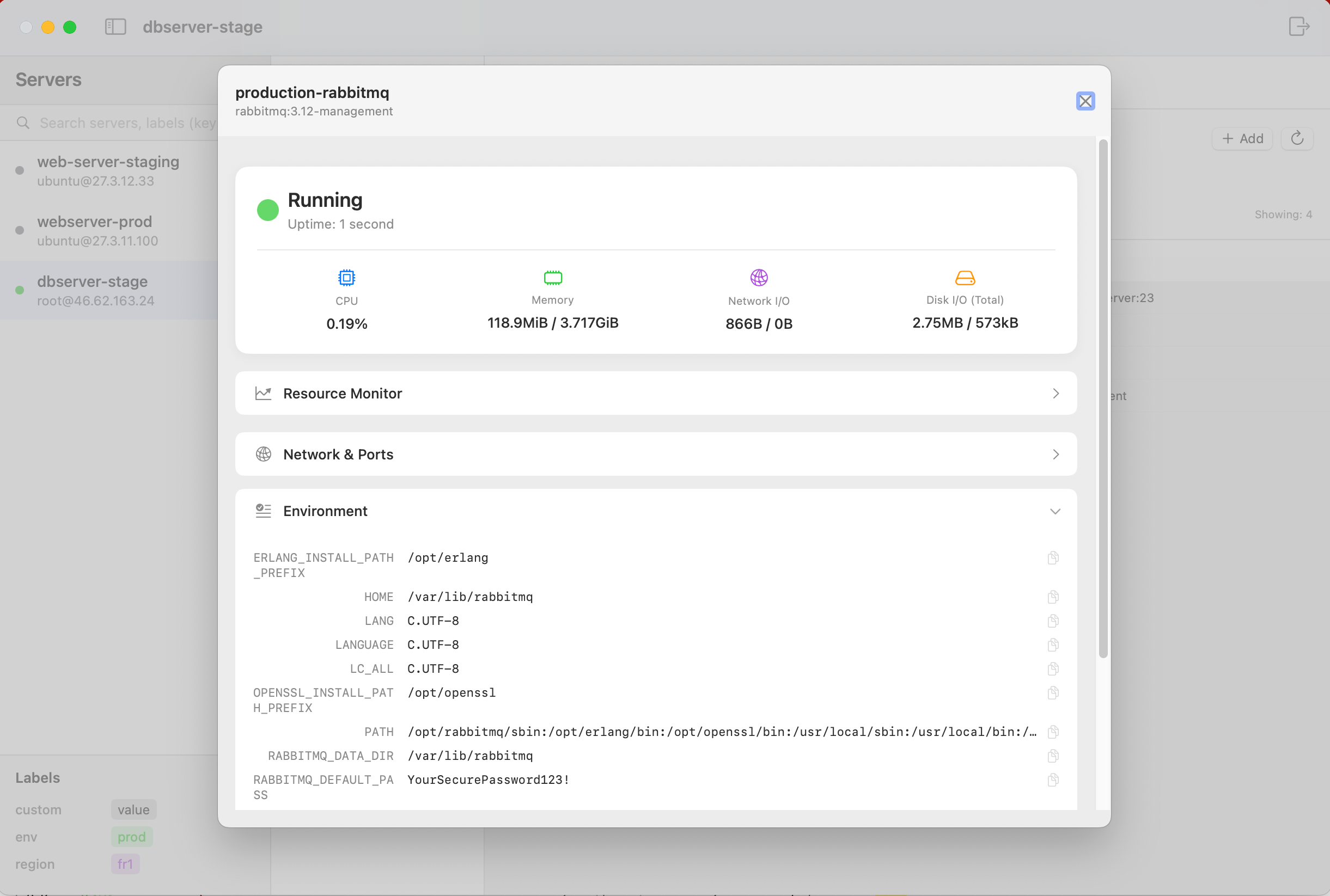How to Deploy and Monitor RabbitMQ Docker Containers
This guide walks through deploying RabbitMQ containers using ServerBuddy's visual interface, covering both basic deployments and production configurations.
Prerequisites
Your Linux server needs:
- Docker or Podman installed
- 512MB+ available RAM
- 10GB+ free disk space
You can check Docker installation by navigating to the "Containers" tab or by running the following in the Terminal:
docker --version
# or
podman --version
Creating a RabbitMQ Container with GUI
Step 1: Navigate to Docker Management
- Connect to your server via ServerBuddy
- Click the "Containers" tab

Step 2: Configure Container Parameters
Click the "+ Add" button in the top right to open the container dialog:
Basic Configuration
- Image:
rabbitmq:3.12-management(includes management UI) - Container Name:
production-rabbitmq(descriptive naming) - Command: Leave empty (uses RabbitMQ default entrypoint)
Port Mappings
Enter the following in the port mappings section:
- Host Port:
5672→ Container Port:5672(AMQP protocol) - Host Port:
15672→ Container Port:15672(Management UI) - Alternative: Use
5673and15673on host if defaults are occupied
Environment Variables (Critical for RabbitMQ)
Add these essential RabbitMQ environment variables:
| Variable | Value |
|---|---|
RABBITMQ_DEFAULT_USER |
admin |
RABBITMQ_DEFAULT_PASS |
YourSecurePassword123! |
RABBITMQ_DEFAULT_VHOST |
/ |
RABBITMQ_ERLANG_COOKIE |
secret-cookie-value |
Volume Mappings for Data Persistence
Configure persistent storage to survive container restarts:
- Mount:
rabbitmq-production-data(Docker volume name) - Container Path:
/var/lib/rabbitmq
For configuration files (optional):
- Mount: rabbitmq-config (Docker volume name)
- Container Path: /etc/rabbitmq
This ensures your queues and messages persist even if the container is removed.
Network Configuration
- Choose custom network for multi-container applications
- ServerBuddy shows available networks in a dropdown
Runtime Options
- Restart Policy: Select "Unless Stopped" for production
- ✅ Run in detached mode: Keeps container running in background
- ❌ Remove on exit: Keep unchecked for message brokers

Step 3: Deploy the Container
Click "Create Container" to:
- Pull the RabbitMQ image if not present
- Create volume directories
- Start the container with specified configuration
- Display creation status
The container should be running within 15-20 seconds.
Monitoring RabbitMQ Container Health
Container Status Indicators
The Docker containers view displays:
Container Status Indicators
- 🟢 Green: Running healthy
- 🟡 Yellow: Starting/restarting
- 🔴 Red: Stopped or errored
- ⚪ Gray: Paused
Available Container Actions
Hover over the container row to access:
- Start/Stop/Restart controls
Checking RabbitMQ Performance
Container Resource Usage
You can view this by double clicking on your container entry in the containers table.

The container details view shows:
- Memory consumption vs. limits
- CPU usage percentage (real-time graph)
- Network I/O rates (inbound/outbound)
- Disk read/write operations
RabbitMQ Internal Metrics
Connect via the Terminal tab:
- Click the Terminal tab
- Access RabbitMQ management tools
Connect to RabbitMQ CLI:
docker exec -it production-rabbitmq rabbitmqctl status
List queues and messages:
docker exec -it production-rabbitmq rabbitmqctl list_queues name messages consumers
Run diagnostic commands:
# Check cluster status
docker exec -it production-rabbitmq rabbitmqctl cluster_status
# List connections
docker exec -it production-rabbitmq rabbitmqctl list_connections
# List channels
docker exec -it production-rabbitmq rabbitmqctl list_channels
# Check memory usage
docker exec -it production-rabbitmq rabbitmqctl status | grep memory
# List users
docker exec -it production-rabbitmq rabbitmqctl list_users
# List virtual hosts
docker exec -it production-rabbitmq rabbitmqctl list_vhosts
Management UI Access
RabbitMQ provides a comprehensive web management interface:
- Open your browser and navigate to:
http://your-server-ip:15672 - Login with credentials:
- Username:
admin(or your configured user) - Password: Your configured password
The management UI provides: - Real-time queue statistics - Connection and channel monitoring - Message rates and throughput graphs - Node memory and disk usage - Exchange and binding visualization
Log Analysis
You can view the logs for the container in the "Logs" tab by changing the log source to "Containers", and then selecting your container from the dropdown list.
The log viewer offers:
- Filtering by log level (ERROR, WARNING)
- Text search across logs
- Real-time updates
Troubleshooting Connection Issues
If you can't connect to RabbitMQ: 1. Check port mapping in container details (5672 for AMQP, 15672 for management) 2. Review container logs for authentication errors 3. Verify RABBITMQ_DEFAULT_USER and RABBITMQ_DEFAULT_PASS are set 4. Confirm firewall rules allow the connections 5. Test management UI access via browser
Security Best Practices
- Change default credentials immediately
- Use strong passwords for all users
- Limit management UI access to specific IPs
- Configure SSL/TLS for encrypted connections
- Set appropriate resource limits and alarms
- Implement proper user permissions and virtual hosts
- Regularly update RabbitMQ images
- Monitor disk space to prevent message loss
- Enable authentication mechanisms like LDAP if needed
Common Issues and Solutions
Container Won't Start
- Check logs for error messages
- Verify ports 5672 and 15672 are available
- Ensure image exists and is pulled
- Check volume mount permissions
- Verify environment variables are correctly set
Connection Refused
- Confirm container is running
- Verify port mappings
- Check firewall rules
- Review authentication credentials
- Ensure client libraries are configured correctly
High Memory Usage
- Check queue lengths and consumer lag
- Review message TTL settings
- Monitor unacknowledged messages
- Configure memory alarms
- Implement queue length limits
Key Takeaways
- Always use volumes for data persistence at
/var/lib/rabbitmq - Management UI on 15672: Essential for monitoring and administration
- AMQP protocol on 5672: Standard messaging port
- Set secure credentials: Never use default guest/guest in production
- Configure resource limits to prevent container from consuming all system resources
- Use restart policies for automatic recovery
- Monitor queue depths to prevent memory issues
- Backup regularly using RabbitMQ export/import tools